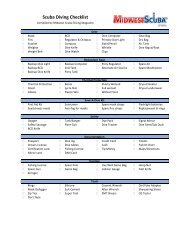DiviNG EBER WARD - Midwest Scuba Diving Magazine
DiviNG EBER WARD - Midwest Scuba Diving Magazine
DiviNG EBER WARD - Midwest Scuba Diving Magazine
Create successful ePaper yourself
Turn your PDF publications into a flip-book with our unique Google optimized e-Paper software.
DIVING SCIENCE<br />
Nitrox: Air on the<br />
Side of Caution<br />
by RICHARD TALAGA PH.D<br />
On a recent dive trip to Florida, a drift dive near<br />
Palm Beach, the divemaster announced “This<br />
will be a 30 minute dive for those diving on air<br />
and a 40 minute dive for those of you diving<br />
on Nitrox”. More and more divers are taking<br />
certification courses to use Nitrox because,<br />
among other benefits, it reduces nitrogen<br />
exposure and allows divers to increase their<br />
bottom time. So, what is Nitrox and what do<br />
we need to know to use it safely? Instructors<br />
report that students find some of the physics<br />
concepts, as they are presented in Nitrox<br />
courses, confusing. The goal of this article<br />
is to clarify those concepts by presenting a<br />
simple description of gas and gas pressure.<br />
We’ll also work through some examples and<br />
solve a few problems that Nitrox students<br />
often encounter.<br />
Nitrox is not just one type of gas. Rather,<br />
it’s a family of gases composed of nitrogen<br />
and oxygen. To extend bottom time, divers<br />
use Nitrox blends with proportionately less<br />
nitrogen and more oxygen than air. More<br />
properly called Enriched Air Nitrox (EANx),<br />
the proportion of oxygen and nitrogen is<br />
custom-blended to fit a specific dive profile.<br />
Most Nitrox gas mixes have 30% to 40%<br />
oxygen. EAN 32, for example, is a Nitrox<br />
gas with 32% oxygen and 68% nitrogen. Of<br />
course the most common Nitrox gas with 21%<br />
oxygen and 79% nitrogen is good old air.<br />
If reducing nitrogen exposure is the goal,<br />
why not remove all of the nitrogen and fill<br />
the cylinder with pure oxygen? It turns out<br />
that too much of a good thing is dangerous!<br />
Overexposure to oxygen leads to a condition<br />
known as oxygen toxicity, which can be<br />
deadly. We can’t tolerate high concentrations<br />
of oxygen in our system just as we can’t<br />
tolerate high concentrations of nitrogen.<br />
Oxygen toxicity is not an issue for divers if<br />
they obey recreational diving limits. However,<br />
Nitrox users are exposed to higher oxygen<br />
concentrations and are trained to understand<br />
oxygen exposure limits and to dive safely<br />
within those limits.<br />
The key to diving Nitrox safely is proper<br />
planning to prevent overexposure to nitrogen<br />
and oxygen. Divers with open water<br />
certification already know how to use dive<br />
tables, designed to prevent overexposure to<br />
nitrogen when diving with air. Nitrox divers<br />
also use dive tables that look like standard<br />
air tables but that are specific to the nitrogen<br />
fraction in their cylinder. Also, because the<br />
oxygen fraction in EANx is greater than in air,<br />
Nitrox divers must calculate their maximum<br />
dive depth to keep oxygen exposure within<br />
acceptable guidelines.<br />
Nitrox calculations are easy but not necessarily<br />
intuitive. If you have a picture of what’s<br />
going on inside a gas container, the math will<br />
make sense and calculations will be more<br />
intuitive. Let’s get started by viewing gas<br />
from a microscopic perspective: just a bunch<br />
of molecules rattling around in a container.<br />
It’s the molecules that are responsible for<br />
gas pressure and different types of molecules<br />
contribute their share to the total pressure.<br />
That’s Dalton’s Law of partial pressure, which<br />
we’ll use several times to illustrate Nitrox<br />
calculations. Let’s enter the microscopic<br />
world of gas molecules and have a look at<br />
what’s going on.<br />
Gas<br />
A gas is a collection of molecules that are not<br />
bound together. Because molecules aren’t<br />
bound together they will quickly disperse<br />
unless they are in some kind of container. In<br />
some sense, molecules are like tiny ping-pong<br />
balls. Imagine a bunch of ping-pong balls<br />
rattling around in a lottery jar. If the glass<br />
breaks, the ping-pong balls will fly out in all<br />
directions, never to return. A gas has to be<br />
kept inside something like a bottle, a balloon,<br />
our lungs…you get the picture.<br />
Air is a “mixed” gas composed of several<br />
“pure” gases. Nitrogen and oxygen amount<br />
to about 99% of air, followed by argon<br />
(0.93%), carbon dioxide (0.038%) and other<br />
trace gases. Since air is a mixed gas, its<br />
molecules are not all alike. Techniques have<br />
been developed to separate mixed gases into<br />
their pure components, which can be packed<br />
into cylinders for commercial use. Let’s look<br />
at the main components of Nitrox: nitrogen<br />
and oxygen. Nitrogen molecules are about<br />
12% lighter than oxygen molecules and both<br />
types of molecules are about the same size:<br />
very small. An important difference between<br />
oxygen and nitrogen is that their chemical<br />
properties are different. Breathing pure<br />
nitrogen won’t sustain life.<br />
Nitrox contains mostly oxygen and nitrogen<br />
molecules, along with trace amounts of other<br />
types of molecules found in air. What are all<br />
those molecules doing? They are moving<br />
in random directions, with speeds averaging<br />
close to a thousand miles per hour bouncing<br />
off each other and off the walls of whatever<br />
contains them. The hotter the gas, the faster<br />
the molecular speeds. A gas is usually<br />
characterized by its absolute temperature,<br />
pressure and how much volume it occupies.<br />
Temperature and volume are terms used by<br />
people in every day life and need only a little<br />
additional explanation, which we will get to a<br />
bit later. Gas pressure, however, is a different<br />
story.<br />
Pressure<br />
The pressure of a gas inside a container is<br />
due to the constant barrage of molecules<br />
bouncing off the container walls. There are so<br />
many molecules hitting the walls at any time<br />
that it doesn’t feel like the jerky pounding of<br />
individual molecules. Instead, it feels like a<br />
constant uniform force pushing outwards.<br />
Molecules are distributed evenly throughout<br />
the volume of the container, so that the<br />
number of molecules bouncing off any square<br />
inch patch of wall is the same as the number<br />
of molecules bouncing off any other patch<br />
on a different part of the wall. This constant<br />
force per unit area is the gas pressure, often<br />
expressed as the number of pounds per square<br />
inch (psi). We conclude that gas pressure is<br />
the same at all locations inside the cylinder.<br />
Three factors affect gas pressure: the number<br />
of molecules in the container, the container’s<br />
volume and the gas temperature. Let’s see how<br />
a change in any one of these factors changes<br />
the pressure. Consider a rigid container,<br />
like a SCUBA cylinder. If we add more gas<br />
molecules into the container, the number of<br />
molecules hitting the cylinder’s inner wall<br />
increases, which raises the pressure. If the<br />
volume does not change, the gas pressure is<br />
proportional to the number of molecules in a<br />
container.<br />
Instead of adding more molecules, we could<br />
heat the cylinder. Heating the cylinder also<br />
heats the gas, so gas molecules have faster<br />
speeds and hit the cylinder wall harder and<br />
more frequently, thereby raising the pressure.<br />
Cooling has the opposite effect and the<br />
pressure is reduced. Gas pressure is directly<br />
proportional to the absolute temperature.<br />
This is known as Charles’ Law.<br />
The third factor is volume. If we transfer all<br />
of the gas molecules from a larger container to<br />
a smaller container, the molecules now don’t<br />
have to travel as far to bounce off a wall. They<br />
hit the wall more frequently, thereby raising<br />
the pressure. In addition, molecules are more<br />
concentrated in the smaller volume, so there<br />
are more molecules for every square inch<br />
patch than before. This also has the effect<br />
of raising the pressure. The end result: a<br />
reduction of the volume causes an increase<br />
of the pressure. Of course the converse<br />
is also true: a bigger volume results in a<br />
smaller pressure. In summary, gas pressure is<br />
inversely proportional to the volume. This is<br />
known as Boyle’s Law.<br />
Gas Fraction, or FO2 and FN2<br />
Since Nitrox comes in a variety of blends, you<br />
have to know the exact percentage of oxygen<br />
and nitrogen in the SCUBA cylinder you will<br />
be using. Nitrox divers are required to measure<br />
the oxygen content with an oxygen analyzer,<br />
which displays fraction of oxygen, FO 2<br />
as a<br />
decimal fraction. For example, if the oxygen<br />
fraction is 0.32, the cylinder contains EAN 32.<br />
The fraction of nitrogen, FN 2<br />
, contained in an<br />
EAN 32 cylinder is equal to 0.68, since FO 2<br />
+<br />
FN 2<br />
must equal 1.00. In other words, EAN 32<br />
consists of 32% oxygen molecules and 68%<br />
nitrogen molecules.<br />
As Nitrox is used and cylinder pressure drops,<br />
FO 2<br />
and FN 2<br />
do not change. Suppose that after<br />
20 minutes of diving on EAN 32 your cylinder<br />
pressure drops from 3,000 psi to 1,600 psi.<br />
FO 2<br />
is still equal to 0.32 and FN 2<br />
is still<br />
equal to 0.68. This should be obvious if you<br />
think about diving with air. Your air cylinder<br />
contains 21% oxygen and 79% nitrogen<br />
18 MIDWEST SCUBA DIVING WINTER 2006










